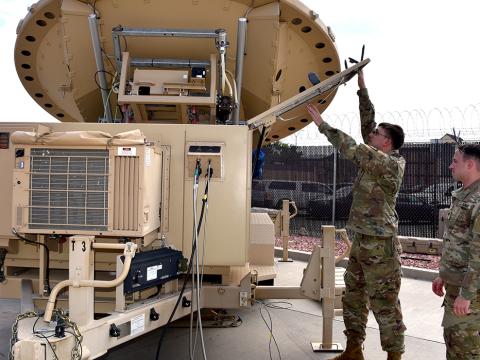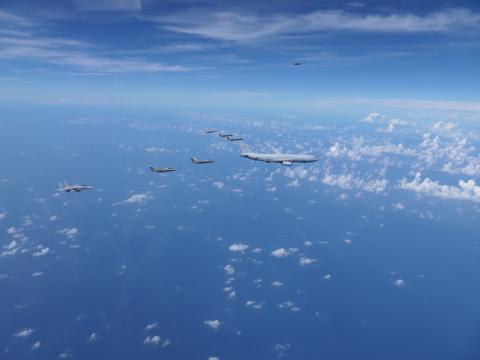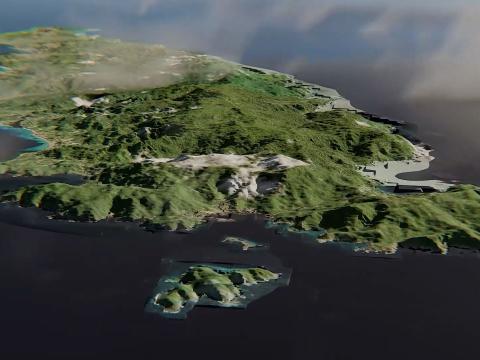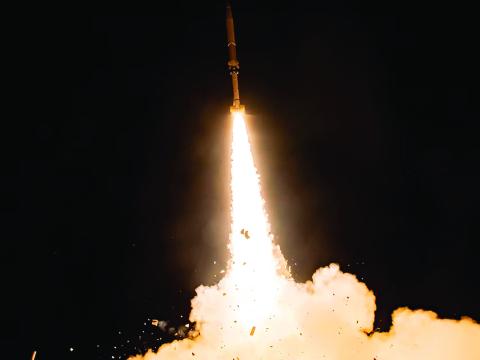Satellite Simulation Equipment Enables Training, Certification
A portable computer can host realistic communications links without scarce and intrusive orbital connectivity.
A simulation tool that creates a virtual satellite allows ground personnel to rehearse satellite communications and operations disciplines without tying up valuable orbiters. The new system enables warfighters to train on, assess and certify orbital communications links without interrupting ongoing satellite operations.
This simulation capability can be applied to single- or multiple-path operations, and users at mobile field units can perform testing and training ordinarily limited to groundstation network hubs. An entire system can be controlled from a single laptop computer running Microsoft Windows.
The system interfaces directly to ultra high frequency (UHF) satellite communications equipment at UHF, intermediate frequency (IF) or baseband frequencies. A user would operate in a simulated environment that features a virtual satellite and corresponds to existing geosynchronous UHF satellite channels.
The system, known as the portable satellite simulator test set, is built by Scientific Research Corporation (SRC), Atlanta, Georgia. It takes the place of a satellite in a communications link, allowing a user to avoid airwave propagation by disconnecting a radio at the antenna and plugging in a cable leading into the simulator to create an ersatz orbiter environment.
The portable simulator is designed to perform like UHF satellite communications equipment in a single channel with four paths. Each path has a separate uplink and a separate downlink delay, which allows a customer to simulate different user terminals placed at wide-ranging geographic locations. Each path can have its own unique satellite link propagation simulation characteristics.
Alan Harris, satellite simulation program manager in SRC’s wireless communications division, states that this system allows simulating how a satellite communications network will operate with its varied terminals and their unique aspects from a baseband user’s perspective. “When you’re transmitting, your uplink is reflected to the other paths’ downlinks,” he explains.
To create a virtual satellite, the simulator takes output from a ground radio and down-converts it. It then converts the output from analog to digital, delays it, processes it and up-converts it back to the radio at its operating frequency.
Development of the simulator is an outgrowth of a U.S. Navy program for satellite communications certification, Harris relates. The company developed a prototype for UHF satellite communications demand assigned multiple access (DAMA) 25-kilohertz certification testing. The Navy still uses this prototype, he maintains, to perform testing at the Space and Naval Warfare Systems Command (SPAWAR) Systems Center in Charleston, South Carolina.
Harris notes that one major challenge in developing the system was obtaining the actual satellite transponder specifications from the Navy to allow accurate simulations. Engineers employed a programmable digital finite impulse response filter that could be redesigned easily, by loading new coefficients, in case the Navy’s specifications were not 100 percent faithful to real-world implementation. SRC has delivered about 40 of these units to Navy and other military laboratories as well as radio manufacturers.
The company has provided the Navy with five portable satellite simulator test sets, and the U.S. Air Force has obtained one. Three units have gone to commercial companies, Harris adds. The French navy has obtained one of the test sets, and the United Kingdom’s Royal Navy is preparing an order for two units and spares. The system supports the U.S. Navy’s UHF fleet satellite (FLTSAT), leased satellite (LEASAT) and UHF follow-on programs.
The system has two new iterations. One is a VXI simulator, or versa module Europe (VME) extension for instrumentation. This satellite simulator has a VXI bus as the backplane that connects the cards within the satellite system. The other new system is a UHF satellite simulator. Harris states that these two simulators can fulfill up to 90 percent of satellite communications testing needs. These two differ from their progenitor in that they are only single-channel, single-path systems and lack the ability to simulate users at different geographic locations.
Reducing to this capability lessens the total cost of the simulator, Harris explains. The original portable simulator, with its one channel featuring four separate paths with their own uplink and downlinks, costs almost four times as much as the single-channel systems. Rather than rendering the original system obsolete, the VXI and UHF simulators simply provide low-cost alternatives for specific user requirements that do not include multiple link sites.
The VXI simulator consists of a single-channel, single-path device placed on a 6U C-size VXI card. A customer can add up to eight simulated satellite channels in the chassis to support testing requirements. If more channels are needed, a VXI extension from one chassis to another will allow the addition of as many chassis as required. A customer can add as many user terminal simulated channels as desired, but they all will have the same channel and path characteristics. Last year, the company delivered its first VXI satellite simulator to the Navy. Motorola received a two-channel version.
While the VXI simulator can be controlled from either a desktop or an embedded VXI personal computer, it also can be controlled remotely through a web browser via standard personal computer or network interfaces. Its frequency response signal distribution module provides a 5-megahertz frequency reference for synchronized systems timing and signal distribution between radios and simulated satellite channels. External radio frequency interference can be injected, and white Gaussian noise can be generated internally.
The UHF simulator features a three-slot VXI backplane that allows it to be configured for one- or two-channel operation. One slot is dedicated to a system controller, and the other two serve the VXI modules. Each module provides a single independent channel with both UHF and IF interfaces as well as independent link simulation parameters.
Users can generate radio frequency signals or adjacent channel signals that can be combined with the system’s UHF output to degrade or stress the satellite communications receiver. A 256-tap finite impulse response digital filter acts as a satellite transponder’s bandpass filter.
Harris states that the main advantage of these simulators is that they provide users with unlimited satellite test time that is otherwise not available. Currently, actual channel test time is available for only a few hours on limited days or at odd times. Harris relates that the significance of these limitations was driven home to the simulation’s developers. While working with a UHF satellite communications DAMA terminal, developers were only able to access satellite links at odd hours, during which they spent most of their time debugging their test setup without getting effective use of their satellite time. “Once we had a simulator, we could get all of our setup completely checked out and do our testing,” he relates. “When we got satellite time, we were able to make good use of that limited time. We used it to verify that we were getting the same actual real performance with our simulator.”
Another advantage offered by Harris is that a user has control over the simulated environment, as opposed to the real satellite world. Knowing that ground equipment is functioning under specific conditions allows an operator to enter factors such as range rate of change or Doppler shift for terminals designed to operate on ships or high-speed aircraft. Variable time delays can simulate uplink and downlink delays either independently or as a combined roundtrip delay relative to each path. Time delays can be static or dynamic to simulate terminals on aircraft moving at Mach 2. The user can simulate Doppler shift factors such as constant platform velocity, platform acceleration and sinusoidal satellite movement arising from inclination angles.
Many users can be found in government laboratories involved with new equipment certification testing. The SPAWAR System Center laboratory in Charleston has multiple units supporting certification testing, Harris states. A similar SPAWAR facility in San Diego hosts a basic satellite simulator and its VXI version.
Designed to be delivered on a laptop, the original simulation software can reside on any computer with Windows 3.1 or Windows 95. The VXI and UHF single-path simulators operate on Windows 95 and Windows NT. No plans exist to upgrade the original simulation to run on an NT platform.
System development is mostly hardware-oriented, Harris says. Running on commercial Windows platforms, the system software focuses on device control so that an operator can enter user-specific scenarios.
The core of the system is a custom-designed circuit based on digital radio frequency memory technology. The digital delay capability requires considerable random access memory to handle a 230- to 280-millisecond delay. Other challenges that the developers overcame focused on bandwidth and sampling speed during analog-to-digital conversion.
Harris explains that the simulation’s radio frequency front end is specific to the frequency band of operation. The simulation is geared to support the UHF frequency band. The company is proposing a similar unit for a commercial system employing different radio frequency front ends for down conversions and up conversions.
UHF satellite channel technology has changed little over the past 20 years, Harris notes. Accordingly, the simulation system is designed to cover all of its bases by mimicking existing UHF satellites in orbit or under deployment.




Comments